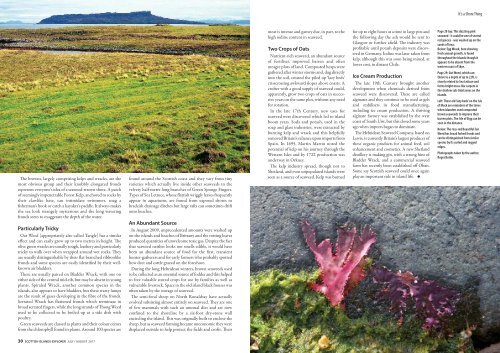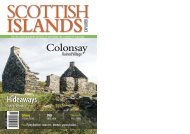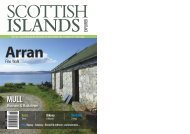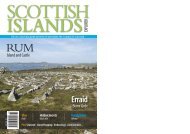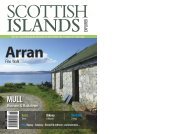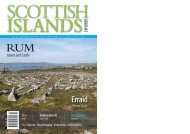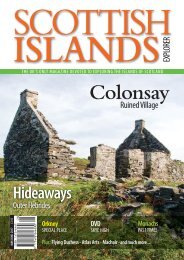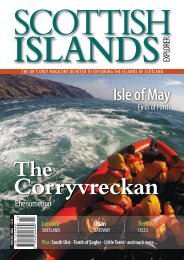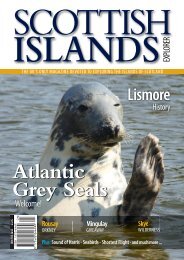Create successful ePaper yourself
Turn your PDF publications into a flip-book with our unique Google optimized e-Paper software.
It’s a Shore Thing<br />
The browns, largely comprising kelps and wracks, are the<br />
most obvious group and their knobbly elongated fronds<br />
represent everyone’s idea of a seaweed-strewn shore. A patch<br />
of seemingly impenetrable Forest Kelp, anchored to rocks by<br />
their clawlike base, can intimidate swimmers, snag a<br />
fisherman’s hook or catch a kayaker’s paddle. It always makes<br />
the sea look strangely mysterious and the long wavering<br />
fronds seem to exaggerate the depth of the water.<br />
Particularly Tricky<br />
Oar Weed (appropriately also called Tangle) has a similar<br />
effect and can easily grow up to two metres in height. The<br />
olive green wracks are usually tough, leathery and particularly<br />
tricky to walk over when wrapped around wet rocks. They<br />
are usually distinguishable by their flat branched ribbonlike<br />
fronds and some species are easily identified by their wellknown<br />
air bladders.<br />
These are usually paired on Bladder Wrack, with one on<br />
either side of the central mid-rib, but may be absent in young<br />
plants. Spiraled Wrack, another common species in the<br />
islands, also appears to have bladders, but these warty lumps<br />
are the result of gases developing in the fibre of the fronds.<br />
Serrated Wrack has flattened fronds which terminate in<br />
broad serrated fingers, while the long strands of Thong Weed<br />
used to be collected to be boiled up as a side dish with<br />
poultry.<br />
Green seaweeds are classed as plants and their colour comes<br />
from the chlorophyll found in plants. Around 100 species are<br />
found around the <strong>Scottish</strong> coast and they vary from tiny<br />
varieties which actually live inside other seaweeds to the<br />
velvety half-metre long branches of Green Sponge Fingers.<br />
Types of Sea Lettuce, whose flattish wriggly leaves frequently<br />
appear in aquariums, are found from exposed shores to<br />
brackish drainage ditches but large rafts can sometimes drift<br />
onto beaches.<br />
An Abundant Source<br />
In <strong>Aug</strong>ust 2009, unprecedented amounts were washed up<br />
on the islands and beaches of Brittany and the rotting leaves<br />
produced quantities of unwelcome toxic gas. Despite the fact<br />
that seaweed neither looks nor smells edible, it would have<br />
been an abundant source of food for the first, transient<br />
hunter-gatherers and for early farmers who probably spotted<br />
how deer and cattle grazed on the foreshore.<br />
During the long Hebridean winters, brown seaweeds used<br />
to be collected as an essential source of fodder and this helped<br />
to free valuable stored crops for use by families as well as<br />
vulnerable livestock. Space in the old island black houses was<br />
often taken by the storage of seaweed.<br />
The semi-feral sheep on North Ronaldsay have actually<br />
evolved subsisting almost entirely on seaweed. They are one<br />
of few mammals with such an unusual diet and are now<br />
confined to the shoreline by a six-foot dry-stone wall<br />
encircling the island. This was originally built to enclose the<br />
sheep, but as seaweed farming became uneconomic they were<br />
displaced outside to help protect the fields and crofts. Their<br />
meat is intense and gamey due, in part, to the<br />
high iodine content in seaweed.<br />
Two Crops of Oats<br />
Nutrient-rich seaweed, an abundant source<br />
of fertiliser, improved barren and often<br />
meagre plots of land. Composted heaps were<br />
gathered after winter storms and, dug directly<br />
into the soil, created the piled up ‘lazy beds’<br />
crisscrossing awkward slopes above coasts. A<br />
crofter with a good supply of seaweed could,<br />
apparently, grow two crops of oats in successive<br />
years on the same plot, without any need<br />
for rotation.<br />
In the late 17th Century, new uses for<br />
seaweed were discovered which led to island<br />
boom years. Soda and potash, used in the<br />
soap and glass industries, were extracted by<br />
burning kelp and wrack and this helpfully<br />
removed Britain’s reliance upon imports from<br />
Spain. In 1695, Martin Martin noted the<br />
potential of kelp on his journey through the<br />
Western Isles and by 1722 production was<br />
underway in Orkney.<br />
The kelp industry spread, though not to<br />
Shetland, and even unpopulated islands were<br />
seen as a source of seaweed. Kelp was burned<br />
for up to eight hours at a time in large pits and<br />
the following day the ash would be sent to<br />
Glasgow or further afield. The industry was<br />
profitable until potash deposits were discovered<br />
in Germany. Iodine was later taken from<br />
kelp, although this was soon being mined, at<br />
lower cost, in distant Chile.<br />
Ice Cream Production<br />
The late 19th Century brought another<br />
development when chemicals derived from<br />
seaweed were discovered. These are called<br />
alginates and they continue to be used as gels<br />
and stabilisers in food manufacturing,<br />
including ice cream production. A thriving<br />
alginate factory was established by the west<br />
coast of South Uist, but this closed some years<br />
ago when imports began to dominate.<br />
The Hebridean Seaweed Company, based on<br />
Lewis, is currently Britain’s largest producer of<br />
these organic products for animal feed, soil<br />
enhancement and cosmetics. A new Shetland<br />
distillery is making gin, with a strong hint of<br />
Bladder Wrack, and a commercial seaweed<br />
farm has recently been established off Oban.<br />
Some say <strong>Scottish</strong> seaweed could once again<br />
play an important role in island life.<br />
Page 28 top: This dazzling pink<br />
seaweed - it could be one of several<br />
red species - was washed up on the<br />
sands of Iona.<br />
Below: Egg Wrack, here showing<br />
fresh annual growth, is found<br />
throughout the islands though it<br />
appears to be absent from the<br />
western coast of Skye.<br />
Page 29: Gut Weed, which can<br />
thrive to a depth of up to 22ft, is<br />
closely related to Sea Lettuce and<br />
forms bright moss-like carpets in<br />
the shallow sub-tidal zones on the<br />
islands.<br />
Left: These old ‘lazy beds’ on the Isle<br />
of Muck are reminders of the times<br />
when islanders used composted<br />
brown seaweeds to improve their<br />
barren plots. The Isle of Eigg can be<br />
seen in the distance.<br />
Below: The rosy-red Beautiful Fan<br />
Weed has broad forked fronds and<br />
can be distinguished from similar<br />
species by its curled and ragged<br />
edges.<br />
Photographs taken by the author,<br />
Roger Butler.<br />
30 SCOTTISH ISLANDS EXPLORER JULY / AUGUST <strong>2017</strong>


